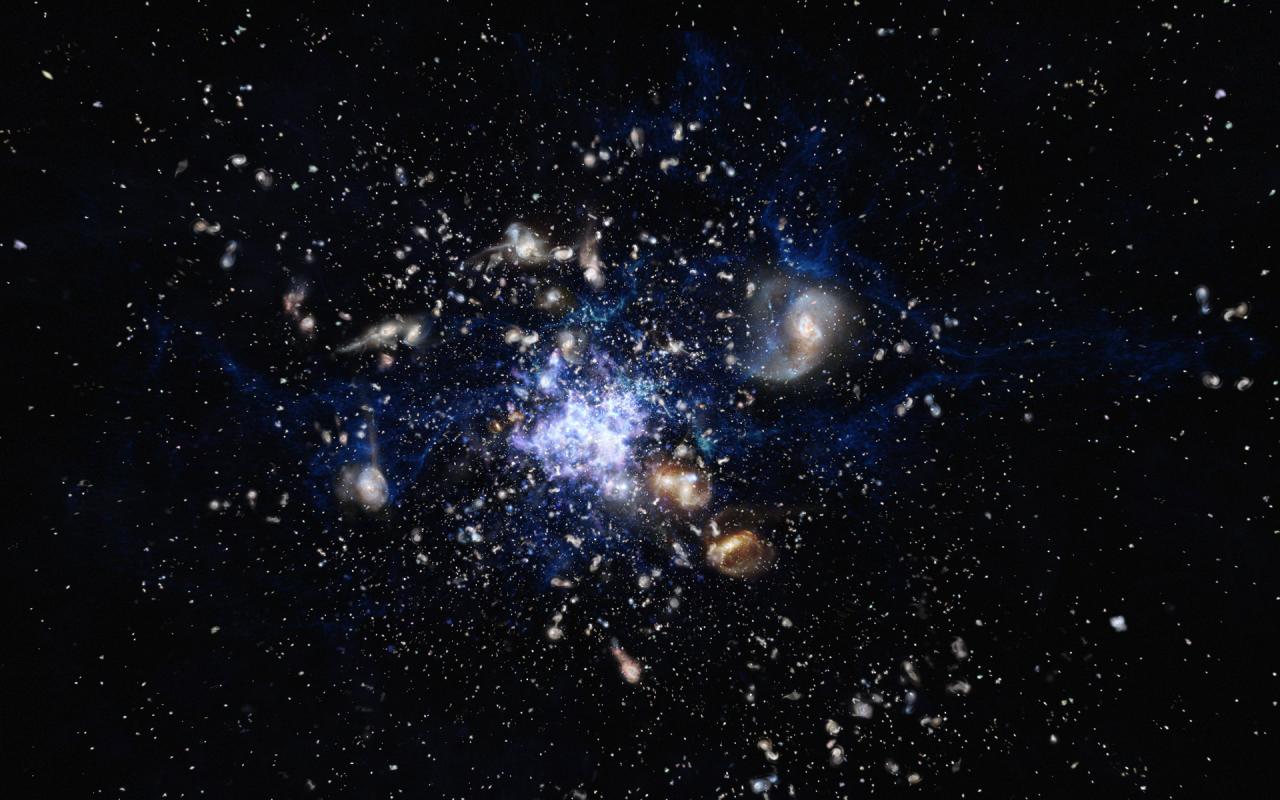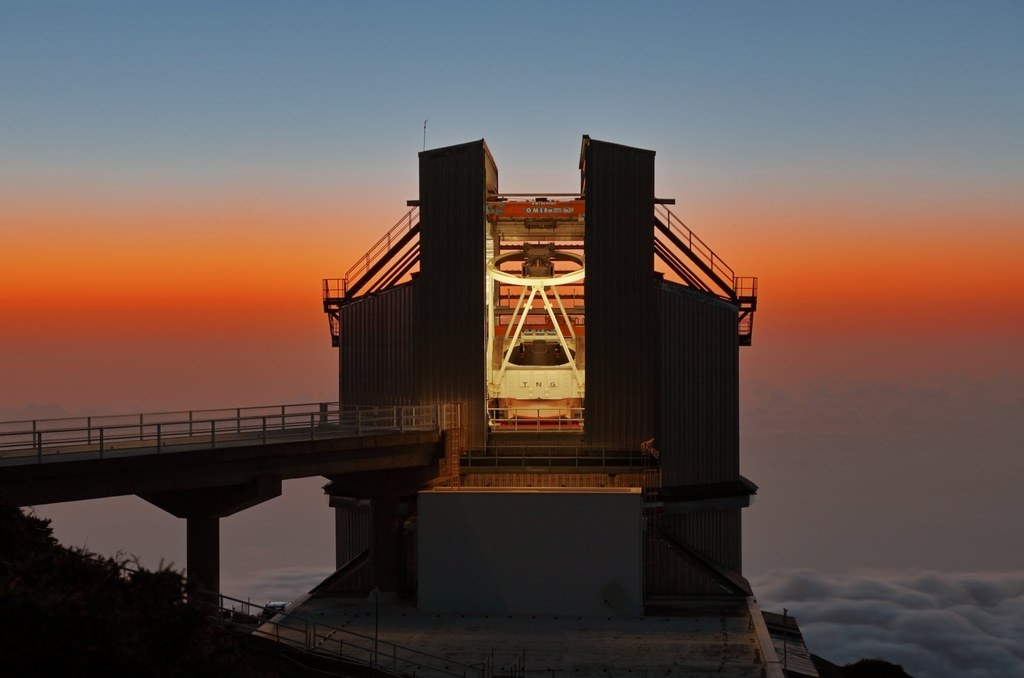11.21.23
Helmut Dannerbauer
helmut@iac.es

Artist’s impression of a protocluster of galaxies in the early Universe showing galaxies forming new stars and interacting with each other. Credit: M. Kornmesser/ESO.
An international research team, led from the Instituto de Astrofísica de Canarias (IAC) and the University of La Laguna (ULL) together with a group of Italian universities, has confirmed a new method for finding protoclusters of galaxies, the largest structures in the early universe. These progenitors of present-day clusters of galaxies played an essential role in the evolution of the universe, but are not easy to find. This study shows that a specific type of galaxies, those which emit radiation at submillimetre wavelengths, are very good indicators of the presence of distant protoclusters. The results are published in the journal Astronomy & Astrophysics [below].
Protoclusters of galaxies were the largest structures in the early universe, only 1000 million years after the Big Bang. The scientific community is very interested in these systems, progenitors of present-day clusters of galaxies; as they are so old they can help us to understand the processes of formation and evolution of the large scale structures in the universe. However, identifying protoclusters is not at all easy, and very few of them are known.
To solve this problem an international scientific team has proposed a new method, focused on a particular type of objects, submillimetre galaxies. They were discovered towards the end of the 1990’s, and their name is due to their intense radiation in the submillimetre waveband, which is the region of the electromagnetic spectrum between the infared, and microwaves. They are among the most massive and dusty galaxies in the universe, and have high star formation rates, which can be one hundred times bigger than that of the Milky Way.
“A number of previous studies had shown evidence that submillimetre galaxies are at the centres of protoclusters of galaxies, but there was a major controversy” explains the first author of the article, Rosa Calvi, a researcher at the University of Ferrara, previously a postdoctoral researcher at the IAC. “Our article presents the first systematic large scale study of a sample of spectroscopically confirmed submillimetre galaxies”.
As a result of the study the team showed, without a doubt, that the submillimetre galaxies are excellent tracers of distant protoclusters. To achieve this result they looked for protoclusters around twelve submillimetre galaxies, and found that eleven of them are hosted, altogether, in eight protoclusters. Out of these eight protoclusters, the new study confirmed independently three that were already known, and the team even found evidence of five new protoclusters. One of these, surrounding the galaxy GN10, is among the most distant protoclusters observed until now. Its light took over 12,500 million years to reach the Earth.
The study also advances our understanding of the physical connection between submillimetre galaxies and their surroundings, showing a correlation, hitherto not observed, between the quantity of molecular gas (the material from which stars are formed) in the submillimetre galaxies, and the overdensities of galaxies and protoclusters. “To explain this correlation we have proposed the hypothesis that the interactions between galaxies and their most dense environments facilitate the collapse of the gas, and the resulting high rate of star formation which characterizes the brightest submillimetre galaxies” says Helmut Dannerbauer, an IAC and ULL researcher who is a co-author of the article.
In the coming years the number of confirmed protoclusters is expected to increase considerably, due to the use of the new generation of instruments, such as the Euclid satellite, one of the main current missions of the European Space Agency (ESA), in which the IAC has active participation.

“With the Euclid satellite, a revolutionary tool for studying large scale structures, we hope to discover and characterize thousands of distant protoclusters, thereby giving an unprecedented impulse to the study of the evolution of galaxies” concludes Gianluca Castignani, a researcher at the University of Bologna, another participant in this study.
See the full article here .
Comments are invited and will be appreciated, especially if the reader finds any errors which I can correct. Use “Reply” at the bottom of the post.
five-ways-keep-your-child-safe-school-shootings
Please help promote STEM in your local schools.
IAC-The Institute of Astrophysics of the Canary Islands [Instituto de Astrofísica de Canarias] (ES) operates two astronomical observatories in the Canary Islands:
Roque de los Muchachos Observatory on La Palma
Teide Observatory on Tenerife.
 The Instituto de Astrofísica the headquarters, which is in La Laguna (Tenerife).
The Instituto de Astrofísica the headquarters, which is in La Laguna (Tenerife).
 Observatorio del Roque de los Muchachos at La Palma (ES) at an altitude of 2400m.
Observatorio del Roque de los Muchachos at La Palma (ES) at an altitude of 2400m.
The seeing statistics at ORM make it the second-best location for optical and infrared astronomy in the Northern Hemisphere, after Mauna Kea Observatory Hawai’i.
 Maunakea Observatories Hawai’i altitude 4,213 m (13,822 ft).
Maunakea Observatories Hawai’i altitude 4,213 m (13,822 ft).
The site also has some of the most extensive astronomical facilities in the Northern Hemisphere; its fleet of telescopes includes the 10.4 m Gran Telescopio Canarias [below], the world’s largest single-aperture optical telescope as of July 2009; the Telescopio Nazionale Galileo (IT) (ES) [below] a 3.58-meter Italian telescope; the William Herschel Telescope (second largest in Europe) [below], and the adaptive optics corrected Swedish 1-m Solar Telescope [below].

 Gran Telescopio Canarias [Instituto de Astrofísica de Canarias ](ES) sited on a volcanic peak 2,267 metres (7,438 ft) above sea level.
Gran Telescopio Canarias [Instituto de Astrofísica de Canarias ](ES) sited on a volcanic peak 2,267 metres (7,438 ft) above sea level.


 Isaac Newton Group 4.2 meter William Herschel Telescope at Roque de los Muchachos Observatory on La Palma in the Canary Islands(ES), 2,396 m (7,861 ft).
Isaac Newton Group 4.2 meter William Herschel Telescope at Roque de los Muchachos Observatory on La Palma in the Canary Islands(ES), 2,396 m (7,861 ft).
 The Swedish 1m Solar Telescope SST at the Roque de los Muchachos observatory on La Palma Spain, Altitude 2,360 m (7,740 ft).
The Swedish 1m Solar Telescope SST at the Roque de los Muchachos observatory on La Palma Spain, Altitude 2,360 m (7,740 ft).
The observatory was established in 1985, after 15 years of international work and cooperation of several countries with the Spanish island hosting many telescopes from Britain, The Netherlands, Spain, and other countries. The island provided better seeing conditions for the telescopes that had been moved to Herstmonceux by the Royal Greenwich Observatory, including the 98 inch aperture Isaac Newton Telescope (the largest reflector in Europe at that time). When it was moved to the island it was upgraded to a 100-inch (2.54 meter), and many even larger telescopes from various nations would be hosted there.
 Tiede Observatory, Tenerife, Canary Islands (ES)
Tiede Observatory, Tenerife, Canary Islands (ES)
Teide Observatory [Observatorio del Teide], IAU code 954, is an astronomical observatory on Mount Teide at 2,390 metres (7,840 ft), located on Tenerife, Spain. It has been operated by the Instituto de Astrofísica de Canarias since its inauguration in 1964. It became one of the first major international observatories, attracting telescopes from different countries around the world because of the good astronomical seeing conditions. Later the emphasis for optical telescopes shifted more towards Roque de los Muchachos Observatory on La Palma.

